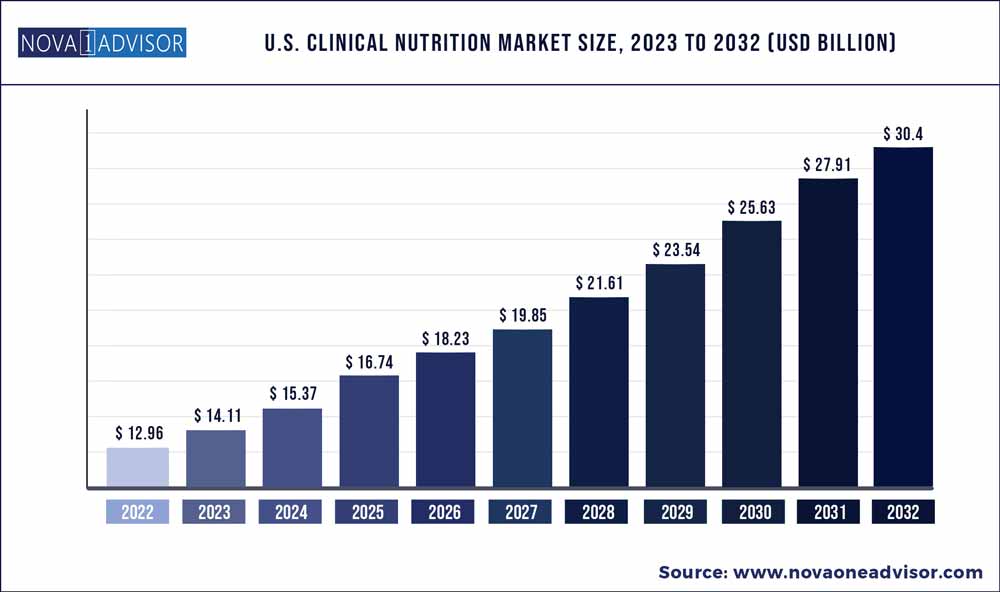The U.S. clinical nutrition market size was exhibited at USD 12.96 billion in 2022 and is projected to hit around USD 30.4 billion by 2032, growing at a CAGR of 8.9% during the forecast period 2023 to 2032.

Key Pointers:
- The Centers for Disease Control and Prevention, in 2022, over 40.7 million people, or 8.9% of the U.S. population were diagnosed with diabetes.
- U.S. clinical nutrition market from infant nutrition segment was more than USD 7 billion in 2022
- The pediatric consumer segment is anticipated to reach USD 16 billion by 2032.
- The metabolic disorders application segment is anticipated to cross USD 9.5 billion by 2032.
- The retail stores distribution channel segment is expected to surpass USD 14 billion by 2032.
Report Scope of the U.S. Clinical Nutrition Market
|
Report Coverage
|
Details
|
|
Market Size in 2023
|
USD 14.11 Billion
|
|
Market Size by 2032
|
USD 30.4 Billion
|
|
Growth Rate from 2023 to 2032
|
CAGR of 8.9%
|
|
Base Year
|
2022
|
|
Forecast Period
|
2023 to 2032
|
|
Segments Covered
|
Product, Consumer, Application, Distribution Channel
|
There is a rising burden of chronic non-communicable diseases across the region. Scientific discoveries about the association of dietary components and cellular mechanisms of illnesses are contributing to the acceptance of clinical nutrition as a multidisciplinary approach to preventing obesity. This approach can also be adopted for the treatment of co-morbidities related to obesity, such as diabetes, hypertension, and cardiovascular conditions. With the increased prevalence of diet-related chronic diseases, the rate of clinical nutrition assessment will gain momentum in countries including the United States.
Based on data from the Centers for Disease Control and Prevention, in 2022, over 40.7 million people, or 8.9% of the U.S. population were diagnosed with diabetes. . The management of this chronic disease is multidimensional and comprises various treatment options including clinical nutrition. The surge in the incidence rate of non-communicable diseases, which can lead to prolonged hospitalization and high mortality rates, will thus contribute to the development of clinical nutrition centers across the nation.
Regulatory bodies, however, have introduced strict mandates related to the sale of clinical nutrition products. The U.S. Food and Drug Administration, for example, has more regulations for clinical nutrition products under the DSHEA (Dietary Supplement Health and Education Act of 1994) than other items including drugs and conventional foods. This strict regulatory framework related to nutritional products may impede the industry development to some extent.
U.S. clinical nutrition market from infant nutrition segment was more than USD 7 billion in 2022, given the rise in cases of preterm birth. According to statistics from the CDC, in 2021, preterm birth impacted 1 in 10 infants in the U.S. Clinical nutritionists attend to these neonates to lower the risk of developmental problems and provide metabolic and immunogenic care. As the number of premature babies grows, the adoption of clinical nutrition for infants is expected to surge to support their optimal growth.
U.S. clinical nutrition market from the pediatric consumer segment is anticipated to reach USD 16 billion by 2032. The surging rate of premature birth and the subsequent increase in the requirement for neonatal nutrition is propelling the segment outlook in the U.S. Due to compromised immune systems, premature babies are susceptible to chronic health conditions. The rising awareness about potential complications for preterm infants will thus escalate the reliance on clinical nutrition and dietetics across the region.
U.S. clinical nutrition market from the metabolic disorders application segment is anticipated to cross USD 9.5 billion by 2032. This is a result of the strong awareness about the advantages of clinical nutrition products in the precise management of metabolic ailments. In healthcare settings, nutrition is vital for patients with metabolic disorders, to boost their immunity, prevent malnutrition, and manage their disease. With the incidence rate of metabolic disorders growing steadily across the U.S., the establishment of clinical nutrition centers will witness significant progress.
U.S. clinical nutrition market share from the retail stores distribution channel segment is expected to surpass USD 14 billion by 2032. Retail outlets can provide customers with seamless access to clinical nutritional supplements, as a wide product range is offered. Retailers also help key brands expand their geographical reach to cater to a vast consumer base. The distribution channel further enables businesses to benefit from reduced distribution and stockholding costs. These advantages will augment the sales of nutritional supplements from retail channels.
Some of the prominent players in the U.S. clinical nutrition Market include:
- Abbott Laboratories (Abbott Nutrition)
- Mead Johnson (Reckitt Benckiser)
- Baxter International Inc.
- Fresenius Kabi
- B Braun Melsungen AG
- Nestle Health Science
- Hero Nutritionals Inc.
- Perrigo,
- Pfizer, Inc.
- Danone
Segments Covered in the Report
This report forecasts the volume and revenue growth at the country level and provides an analysis of the latest industry trends in each of the sub-segments from 2018 to 2032. For this study, Nova one advisor has segmented the U.S. clinical nutrition market.
By Product
- Infant Nutrition
- Milk Based
- Soy Based
- Organic Formulas
- Others
- Enteral Nutrition
- Standard Composition
- Disease Specific Composition
- Parenteral Nutrition
- Amino Acids
- Fats
- Carbohydrates
- Others
By Consumer
By Application
- Cancer
- Metabolic Disorders
- Neurological Diseases
- Gastrointestinal Disorders
- Others
By Distribution Channel
- Retail Stores
- Pharmacies & Drug Stores
- Online Channels
- Others

